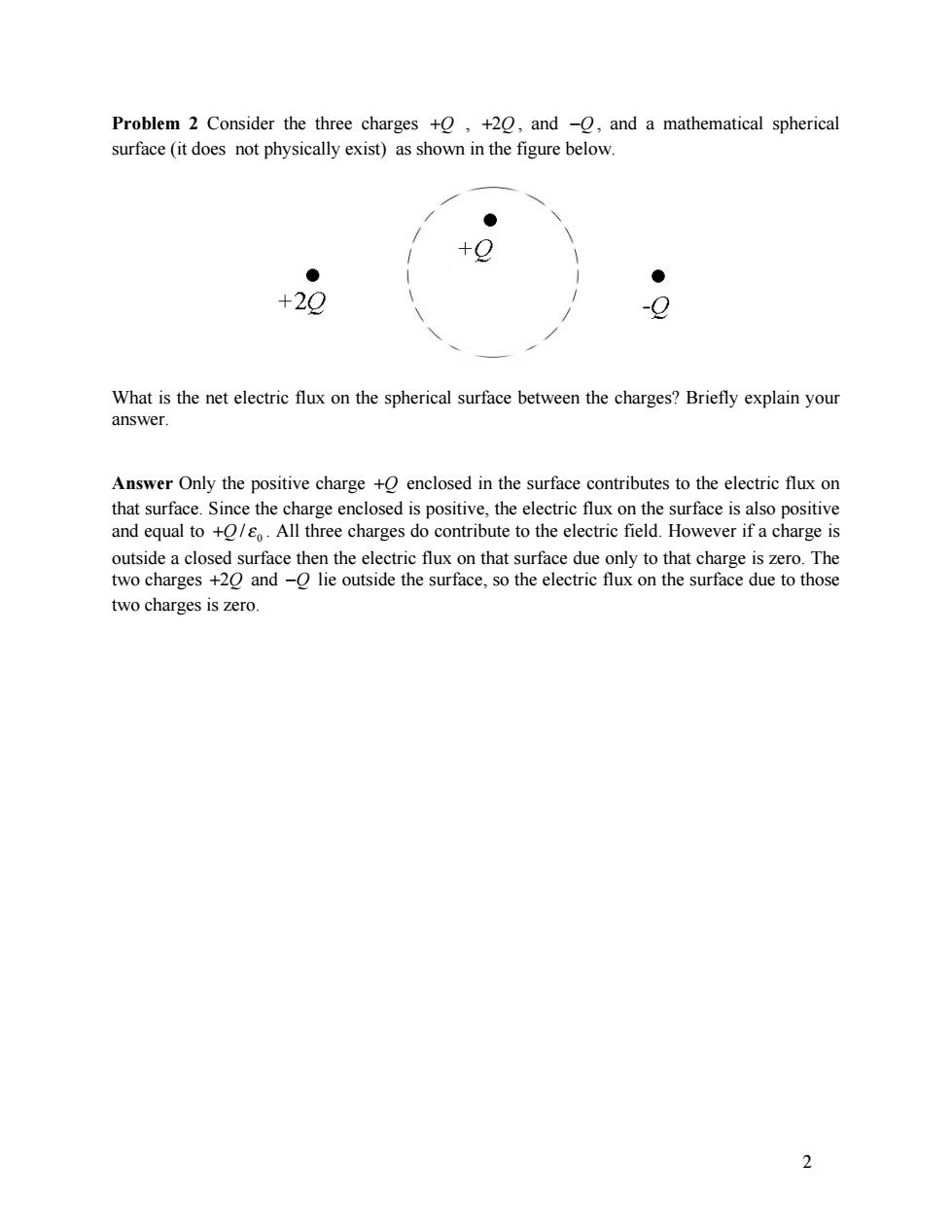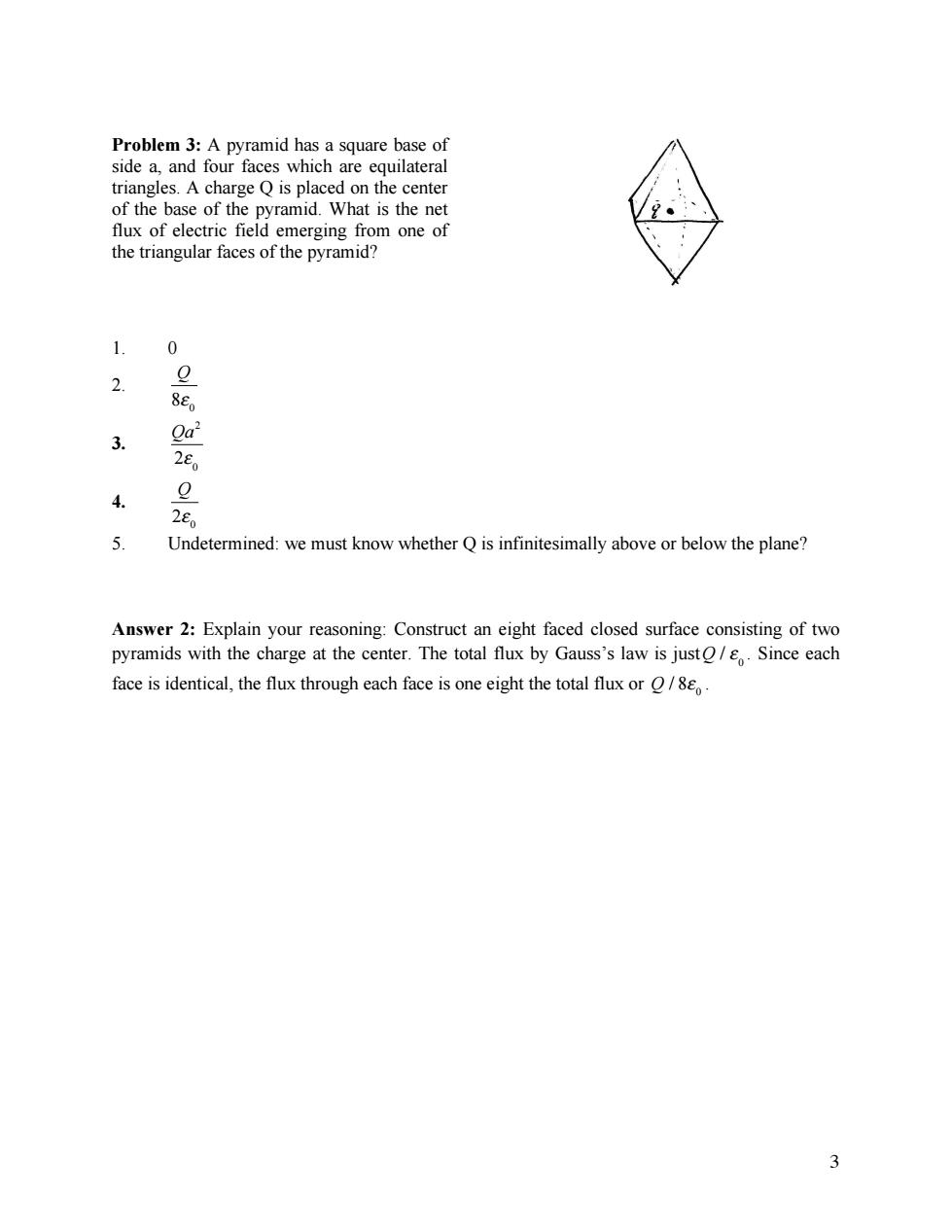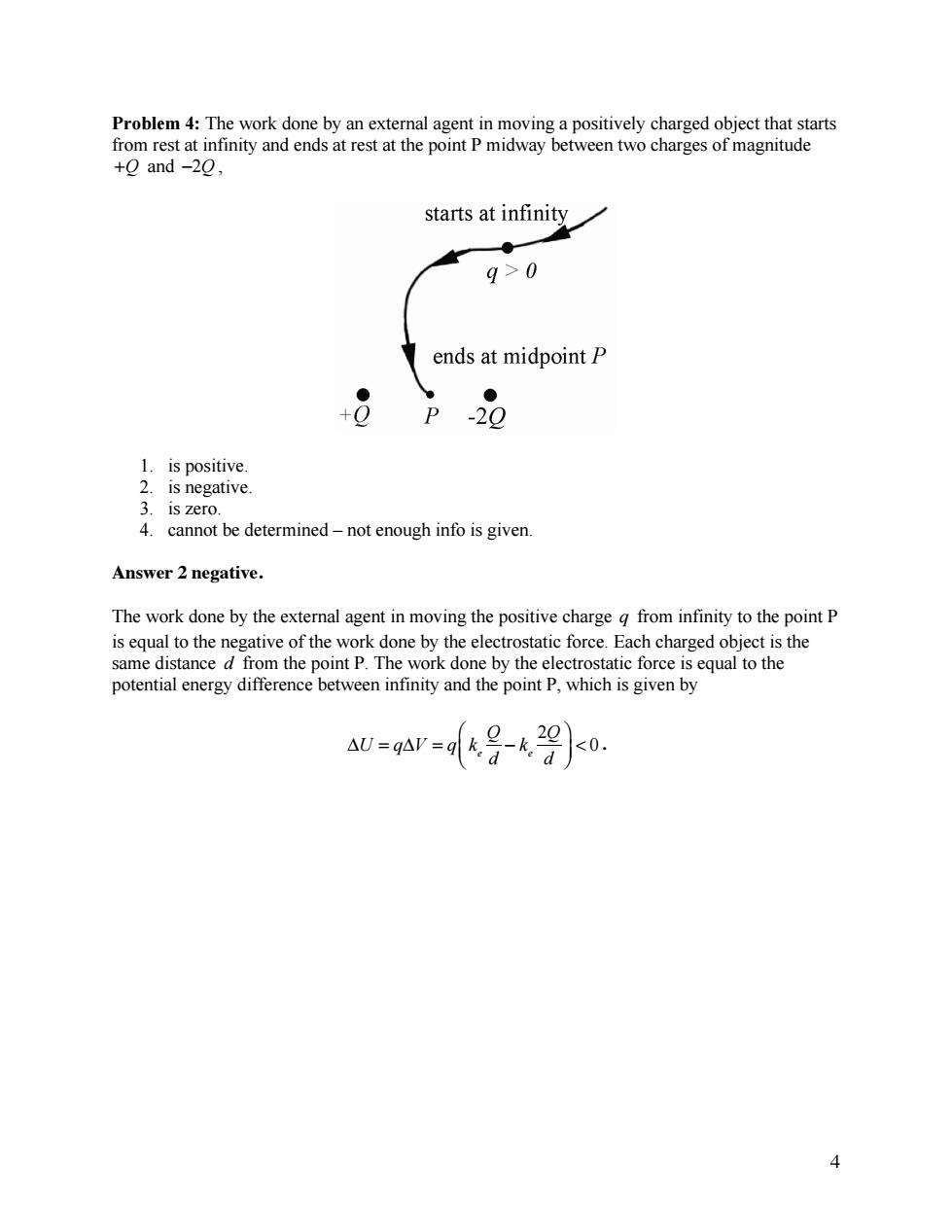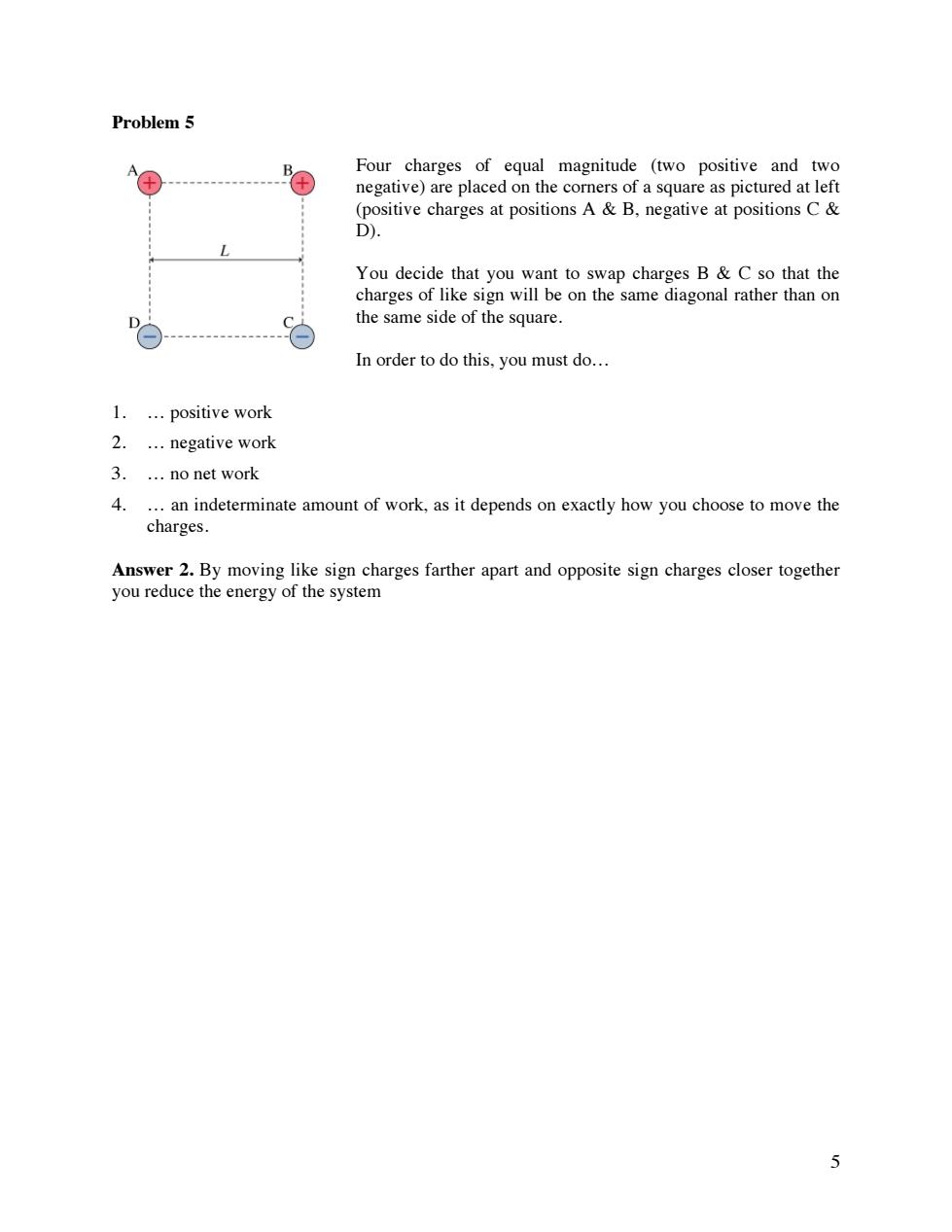
MASSACHUSETTS INSTITUTE OF TECHNOLOGY Department of Physics 8.02 Spring 2013 Exam 1 Practice Problems Solutions Part I:Short Questions and Concept Questions Problem 1:Spark Plug Pictured at right is a typical spark plug(for scale,the thread diameter is about 10 mm). 10 mm About what voltage does your car ignition system need to generate to make a spark,if the breakdown field in a gas/air mixture is about 10 times higher than in air?For those of you unfamiliar with spark plugs,the spark is generated in the gap at the left of the top picture(top of the bottom picture).The white on the right is a ceramic which acts as an insulator between the high voltage center and the grounded outer(threaded)part. Answer. From the picture,if the threads have a diameter of 10 mm,then the gap is about 0.5 mm.The breakdown is 10 times higher than in air,so its 3 x 10'V/m.So to get breakdown you need a potential difference across the gap of △V=Ed=(3×10V-m-)5×104m)=1.5×104V 1
1 MASSACHUSETTS INSTITUTE OF TECHNOLOGY Department of Physics 8.02 Spring 2013 Exam 1 Practice Problems Solutions Part I: Short Questions and Concept Questions Problem 1: Spark Plug Pictured at right is a typical spark plug (for scale, the thread diameter is about 10 mm). About what voltage does your car ignition system need to generate to make a spark, if the breakdown field in a gas/air mixture is about 10 times higher than in air? For those of you unfamiliar with spark plugs, the spark is generated in the gap at the left of the top picture (top of the bottom picture). The white on the right is a ceramic which acts as an insulator between the high voltage center and the grounded outer (threaded) part. Answer. From the picture, if the threads have a diameter of 10 mm, then the gap is about 0.5 mm. The breakdown is 10 times higher than in air, so its 3 x 107 V/m. So to get breakdown you need a potential difference across the gap of !V ! Ed = (3"107 V#m$1 )(5"10$4 m) = 1.5"104 V

Problem 2 Consider the three charges +o,+20,and -O,and a mathematical spherical surface(it does not physically exist)as shown in the figure below. ● ● +2Q Q What is the net electric flux on the spherical surface between the charges?Briefly explain your answer. Answer Only the positive charge enclosed in the surface contributes to the electric flux on that surface.Since the charge enclosed is positive,the electric flux on the surface is also positive and equal to +/.All three charges do contribute to the electric field.However if a charge is outside a closed surface then the electric flux on that surface due only to that charge is zero.The two charges +20 and-O lie outside the surface,so the electric flux on the surface due to those two charges is zero. 2
2 Problem 2 Consider the three charges +Q , +2Q , and !Q , and a mathematical spherical surface (it does not physically exist) as shown in the figure below. What is the net electric flux on the spherical surface between the charges? Briefly explain your answer. Answer Only the positive charge +Q enclosed in the surface contributes to the electric flux on that surface. Since the charge enclosed is positive, the electric flux on the surface is also positive and equal to 0 +Q / ! . All three charges do contribute to the electric field. However if a charge is outside a closed surface then the electric flux on that surface due only to that charge is zero. The two charges +2Q and !Q lie outside the surface, so the electric flux on the surface due to those two charges is zero

Problem 3:A pyramid has a square base of side a,and four faces which are equilateral triangles.A charge Q is placed on the center of the base of the pyramid.What is the net flux of electric field emerging from one of the triangular faces of the pyramid? 1. 0 2. Q 8Eo 3. Q 2e0 4. 旦 2Eo 5. Undetermined:we must know whether Q is infinitesimally above or below the plane? Answer 2:Explain your reasoning:Construct an eight faced closed surface consisting of two pyramids with the charge at the center.The total flux by Gauss's law is just/Since each face is identical,the flux through each face is one eight the total flux or /88 3
3 Problem 3: A pyramid has a square base of side a, and four faces which are equilateral triangles. A charge Q is placed on the center of the base of the pyramid. What is the net flux of electric field emerging from one of the triangular faces of the pyramid? 1. 0 2. Q 8! 0 3. Qa 2 2! 0 4. Q 2! 0 5. Undetermined: we must know whether Q is infinitesimally above or below the plane? Answer 2: Explain your reasoning: Construct an eight faced closed surface consisting of two pyramids with the charge at the center. The total flux by Gauss’s law is justQ / ! 0 . Since each face is identical, the flux through each face is one eight the total flux or Q / 8! 0

Problem 4:The work done by an external agent in moving a positively charged object that starts from rest at infinity and ends at rest at the point P midway between two charges of magnitude +0 and -20, starts at infinity ● 9>0 ends at midpoint p ● -29 1.is positive. 2.is negative 3.is zero 4.cannot be determined-not enough info is given. Answer 2 negative. The work done by the external agent in moving the positive charge g from infinity to the point P is equal to the negative of the work done by the electrostatic force.Each charged object is the same distance d from the point P.The work done by the electrostatic force is equal to the potential energy difference between infinity and the point P,which is given by A=qar=g号629}0 4
4 Problem 4: The work done by an external agent in moving a positively charged object that starts from rest at infinity and ends at rest at the point P midway between two charges of magnitude +Q and !2Q , 1. is positive. 2. is negative. 3. is zero. 4. cannot be determined – not enough info is given. Answer 2 negative. The work done by the external agent in moving the positive charge q from infinity to the point P is equal to the negative of the work done by the electrostatic force. Each charged object is the same distance d from the point P. The work done by the electrostatic force is equal to the potential energy difference between infinity and the point P, which is given by !U = q!V = q ke Q d " ke 2Q d # $ % & ' ( < 0

Problem 5 Four charges of equal magnitude (two positive and two negative)are placed on the corners of a square as pictured at left (positive charges at positions A &B,negative at positions C& D). You decide that you want to swap charges B C so that the charges of like sign will be on the same diagonal rather than on the same side of the square. In order to do this,you must do... 1. ..positive work 2. ..negative work 3. ..no net work 4. ..an indeterminate amount of work,as it depends on exactly how you choose to move the charges. Answer 2.By moving like sign charges farther apart and opposite sign charges closer together you reduce the energy of the system
5 Problem 5 Four charges of equal magnitude (two positive and two negative) are placed on the corners of a square as pictured at left (positive charges at positions A & B, negative at positions C & D). You decide that you want to swap charges B & C so that the charges of like sign will be on the same diagonal rather than on the same side of the square. In order to do this, you must do… 1. … positive work 2. … negative work 3. … no net work 4. … an indeterminate amount of work, as it depends on exactly how you choose to move the charges. Answer 2. By moving like sign charges farther apart and opposite sign charges closer together you reduce the energy of the system